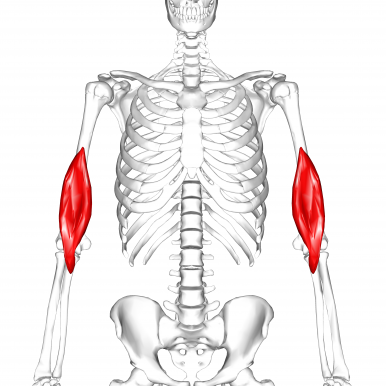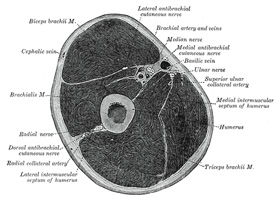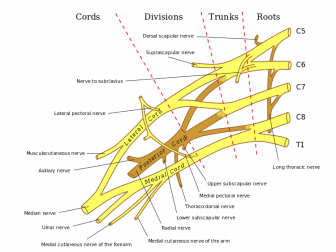Brachialis: Difference between revisions
No edit summary |
mNo edit summary |
||
| Line 2: | Line 2: | ||
'''Top Contributors''' - {{Special:Contributors/{{FULLPAGENAME}}}} | '''Top Contributors''' - {{Special:Contributors/{{FULLPAGENAME}}}} | ||
</div>[[File:Brachialis muscle1.png|alt=|thumb|386x386px|The Brachialis Muscle<ref> | </div>[[File:Brachialis muscle1.png|alt=|thumb|386x386px|The Brachialis Muscle<ref>Anatomography. English: Brachialis muscle. [Internet]. 2013 [cited 2018 Mar 21]. Available from: <nowiki>https://commons.wikimedia.org/wiki/File:Brachialis_muscle11.png</nowiki></ref> | ||
]] | ]] | ||
== Description == | == Description == | ||
The brachialis muscle is the primary flexor of the elbow. This muscle is located in the anterior compartment of the arm along with the [[Biceps brachii]] and coracobrachialis. | The brachialis muscle is the primary flexor of the elbow. This muscle is located in the anterior compartment of the arm along with the [[Biceps brachii]] and coracobrachialis. | ||
=== Origin === | === Origin === | ||
Distal anterior aspect of the humerus, deep to the biceps brachii.<ref name=":0">Brachialis. | Distal anterior aspect of the humerus, deep to the biceps brachii.<ref name=":0">Brachialis [Internet]. [cited 2018 Mar 21]. Available from: <nowiki>https://rad.washington.edu/muscle-atlas/brachialis/</nowiki></ref> | ||
=== Insertion === | === Insertion === | ||
| Line 13: | Line 13: | ||
=== Nerve === | === Nerve === | ||
The brachialis muscle is innervated by the musculocutaneous nerve and components of the radial nerve. The radial nerve descends in the groove between the brachialis and brachioradialis muscles, above the elbow. Of the muscles in the anterior compartment, the biceps brachii and the brachialis are innervated by C5 and C6 nerve roots.<ref name=":1"> | The brachialis muscle is innervated by the musculocutaneous nerve and components of the radial nerve. The radial nerve descends in the groove between the brachialis and brachioradialis muscles, above the elbow. Of the muscles in the anterior compartment, the biceps brachii and the brachialis are innervated by C5 and C6 nerve roots.<ref name=":1">Gray, Henry. 1918. Anatomy of the Human Body [Internet]. [cited 2018 Mar 21]. Available from: <nowiki>http://www.bartleby.com/107/</nowiki> | ||
</ref>[[File:Brachial-plexus-2.png|thumb|336x336px]] | </ref>[[File:Brachial-plexus-2.png|thumb|336x336px]] | ||
| Line 28: | Line 20: | ||
== Function == | == Function == | ||
The brachialis muscle has a large cross sectional area, providing it with more strength than the biceps brachii and the coracobrachialis.<ref name=":2">Marieb, | The brachialis muscle has a large cross sectional area, providing it with more strength than the biceps brachii and the coracobrachialis.<ref name=":2">Marieb EN, Hoehn K. Human anatomy & physiology. 10th ed. Boston, Ma: Pearson; 2016.</ref> In order to isolate the brachialis muscle the forearm needs to be in pronation, due to the biceps brachii's function as a supinator and flexor. <ref name=":2" /> By pronating the forearm the biceps is put into a mechanical disadvantage. | ||
[[File:Arm cross section.jpg|thumb|Cross Sectional View of the Upper Arm<ref name=":1" />|275x275px]] | [[File:Arm cross section.jpg|thumb|Cross Sectional View of the Upper Arm<ref name=":1" />|275x275px]] | ||
== Clinical relevance == | == Clinical relevance == | ||
The brachialis muscle can be commonly injured by repetitive forceful contractions or muscular contractions with the arm in hyperextension. This is commonly seen in climbers, due to the pronation of the hand and the extended started position.<ref>Bond T. Tom’s Physiotherapy Blog: “Climber’s elbow” - Brachialis Tendonitis [Internet]. Tom’s Physiotherapy Blog. 2013 [cited 2018 Mar 21]. Available from: <nowiki>http://thomasbondphysio.blogspot.com/2013/06/climbers-elbow-brachialis-tendonitis.html</nowiki></ref> Physical activity that involve a lot of pull ups, curls, and rope climbing can also initiate brachialis muscle pain.<ref>Brachialis muscle pain & trigger points [Internet]. [cited 2018 Mar 21]. Available from: <nowiki>https://www.muscle-joint-pain.com/trigger-points/trigger-point-self-treatment/brachialis/</nowiki></ref> A strain to the brachialis tendon can also cause a patient to present with lacking elbow extension due to painful end-range stretching of the tendon. Due to the location of the pain, [[Medial Epicondylitis]] and lateral epicondylitis should also be evaluated. | |||
Cubital Fossa- the brachialis creates the floor of the cubital fossa<ref name=":1" /> | Cubital Fossa- the brachialis creates the floor of the cubital fossa<ref name=":1" /> | ||
| Line 41: | Line 35: | ||
== Assessment == | == Assessment == | ||
To assess the strength of the brachialis place the elbow at 90 degrees of flexion with the forearm fully pronated. Then have the patient resist an inferior force placed on the distal forearm.<ref>Muscolino | To assess the strength of the brachialis place the elbow at 90 degrees of flexion with the forearm fully pronated. Then have the patient resist an inferior force placed on the distal forearm.<ref>Muscolino JE. Kinesiology: the skeletal system and muscle function. 2nd ed. St. Louis, MO: Mosby/Elsevier; 2011.</ref> | ||
{{#ev:youtube|bXt4DqXM6-8}} | {{#ev:youtube|bXt4DqXM6-8}} | ||
Revision as of 05:17, 21 March 2018
Top Contributors - Eric Henderson, Matthew Chin, Kirenga Bamurange Liliane, Kim Jackson, Joao Costa and Wendy Snyders

Description[edit | edit source]
The brachialis muscle is the primary flexor of the elbow. This muscle is located in the anterior compartment of the arm along with the Biceps brachii and coracobrachialis.
Origin[edit | edit source]
Distal anterior aspect of the humerus, deep to the biceps brachii.[2]
Insertion[edit | edit source]
Coronoid process and the ulnar tuberosity.[2]
Nerve[edit | edit source]
The brachialis muscle is innervated by the musculocutaneous nerve and components of the radial nerve. The radial nerve descends in the groove between the brachialis and brachioradialis muscles, above the elbow. Of the muscles in the anterior compartment, the biceps brachii and the brachialis are innervated by C5 and C6 nerve roots.[3]
Artery[edit | edit source]
Muscular branches of brachial artery, recurrent radial artery.[2]
Function[edit | edit source]
The brachialis muscle has a large cross sectional area, providing it with more strength than the biceps brachii and the coracobrachialis.[4] In order to isolate the brachialis muscle the forearm needs to be in pronation, due to the biceps brachii's function as a supinator and flexor. [4] By pronating the forearm the biceps is put into a mechanical disadvantage.

Clinical relevance[edit | edit source]
The brachialis muscle can be commonly injured by repetitive forceful contractions or muscular contractions with the arm in hyperextension. This is commonly seen in climbers, due to the pronation of the hand and the extended started position.[5] Physical activity that involve a lot of pull ups, curls, and rope climbing can also initiate brachialis muscle pain.[6] A strain to the brachialis tendon can also cause a patient to present with lacking elbow extension due to painful end-range stretching of the tendon. Due to the location of the pain, Medial Epicondylitis and lateral epicondylitis should also be evaluated.
Cubital Fossa- the brachialis creates the floor of the cubital fossa[3]
Posterior interosseous nerve syndrome
Assessment[edit | edit source]
To assess the strength of the brachialis place the elbow at 90 degrees of flexion with the forearm fully pronated. Then have the patient resist an inferior force placed on the distal forearm.[7]
Resources[edit | edit source]
- ↑ Anatomography. English: Brachialis muscle. [Internet]. 2013 [cited 2018 Mar 21]. Available from: https://commons.wikimedia.org/wiki/File:Brachialis_muscle11.png
- ↑ 2.0 2.1 2.2 Brachialis [Internet]. [cited 2018 Mar 21]. Available from: https://rad.washington.edu/muscle-atlas/brachialis/
- ↑ 3.0 3.1 3.2 Gray, Henry. 1918. Anatomy of the Human Body [Internet]. [cited 2018 Mar 21]. Available from: http://www.bartleby.com/107/
- ↑ 4.0 4.1 Marieb EN, Hoehn K. Human anatomy & physiology. 10th ed. Boston, Ma: Pearson; 2016.
- ↑ Bond T. Tom’s Physiotherapy Blog: “Climber’s elbow” - Brachialis Tendonitis [Internet]. Tom’s Physiotherapy Blog. 2013 [cited 2018 Mar 21]. Available from: http://thomasbondphysio.blogspot.com/2013/06/climbers-elbow-brachialis-tendonitis.html
- ↑ Brachialis muscle pain & trigger points [Internet]. [cited 2018 Mar 21]. Available from: https://www.muscle-joint-pain.com/trigger-points/trigger-point-self-treatment/brachialis/
- ↑ Muscolino JE. Kinesiology: the skeletal system and muscle function. 2nd ed. St. Louis, MO: Mosby/Elsevier; 2011.







